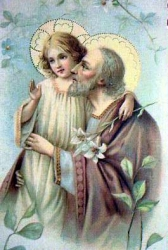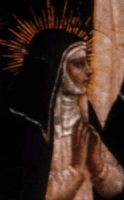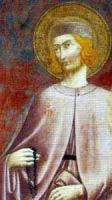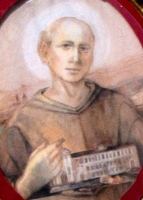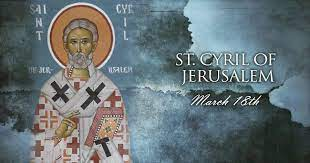*✞ தூய சூசையப்பர் ( யோசேப்பு )புகழ்மாலை ✞*
சுவாமி கிருபையாயிரும்.
கிறிஸ்துவே கிருபையாயிரும்.
சுவாமி கிருபையாயிரும்.
கிறிஸ்துவே, எங்கள் பிரார்த்தனையைக் கேட்டருளும்.
கிறிஸ்துவே, எங்கள் பிரார்த்தனையை நன்றாகக் கேட்டருளும்.
பரமண்டலங்களிலே இருக்கிற பிதாவாகிய சர்வேசுரா!
-எங்களைத் தயை பண்ணி இரட்சியும் சுவாமி.
உலகத்தை மீட்டு இரட்சித்த சுதனாகிய சர்வேசுரா!
-எங்களைத் தயை பண்ணி இரட்சியும் சுவாமி.
தூய ஆவியாகிய சர்வேசுரா!
-எங்களைத் தயை பண்ணி இரட்சியும் சுவாமி.
தமத்திருத்துவமாயிருக்கிற ஏக சர்வேசுரா!
-எங்களைத் தயை பண்ணி இரட்சியும் சுவாமி.
புனித மரியாயே!
-எங்களுக்காக வேண்டிக்கொள்ளும்.
புனித சூசையப்பரே!
-எங்களுக்காக வேண்டிக்கொள்ளும்.
தாவீது இராஜாவின் கீர்த்தி பெற்ற புத்திரனே!
-எங்களுக்காக வேண்டிக்கொள்ளும்.
பிதாப்பிதாக்களின் மகிமையே!
-எங்களுக்காக வேண்டிக்கொள்ளும்.
தேவ தாயாரின் பத்தாவே!
-எங்களுக்காக வேண்டிக்கொள்ளும்.
கன்னிமரியாளின் கற்புள்ள காவலனே!
-எங்களுக்காக வேண்டிக்கொள்ளும்.
தேவகுமாரனை வளர்த்த தகப்பனே!
-எங்களுக்காக வேண்டிக்கொள்ளும்.
கிறிஸ்துநாதரை உற்சாகப் பற்றுதலுடன் காப்பாற்றினவரே!
-எங்களுக்காக வேண்டிக்கொள்ளும்.
திருக்குடும்பத்தின் தலைமையானவரே!
-எங்களுக்காக வேண்டிக்கொள்ளும்.
உத்தம நீதிமானான புனித சூசையப்பரே!
-எங்களுக்காக வேண்டிக்கொள்ளும்.
உத்தம விரத்தரான புனித சூசையப்பரே!
-எங்களுக்காக வேண்டிக்கொள்ளும்.
உத்தம விவேகமுடைத்தான புனித சூசையப்பரே!
-எங்களுக்காக வேண்டிக்கொள்ளும்.
உத்தம தைரியசாலியான புனித சூசையப்பரே!
-எங்களுக்காக வேண்டிக்கொள்ளும்.
உத்தம கீழ்ப்படிதலுள்ளவரான புனித சூசையப்பரே!
-எங்களுக்காக வேண்டிக்கொள்ளும்.
உத்தம பிரமாணிக்கமுள்ளவரான புனித சூசையப்பரே!
-எங்களுக்காக வேண்டிக்கொள்ளும்.
பொறுமையின் கண்ணாடியே!
-எங்களுக்காக வேண்டிக்கொள்ளும்.
தரித்திரனின் அன்பனே!
-எங்களுக்காக வேண்டிக்கொள்ளும்.
தொழிலாளிகளுக்கு மாதிரிகையே!
-எங்களுக்காக வேண்டிக்கொள்ளும்.
சம்சார வாழ்க்கையின் ஆபரணமே!
-எங்களுக்காக வேண்டிக்கொள்ளும்.
கன்னிகையின் காவலனே!
-எங்களுக்காக வேண்டிக்கொள்ளும்.
குடும்பங்களுக்கு ஆதரவே!
-எங்களுக்காக வேண்டிக்கொள்ளும்.
கஸ்திப்படுகிறவர்களுக்கு ஆறுதலே!
-எங்களுக்காக வேண்டிக்கொள்ளும்.
வியாதிக்காரர்களுக்கு நம்பிக்கையே!
-எங்களுக்காக வேண்டிக்கொள்ளும்.
மரிக்கிறவர்களுக்கு பாதுகாவலரே!
-எங்களுக்காக வேண்டிக்கொள்ளும்.
பசாசுகளை நடுநடுங்கச் செய்கிறவரே!
-எங்களுக்காக வேண்டிக்கொள்ளும்.
பரிசுத்த திருச்சபையின் பரிபாலனே!
-எங்களுக்காக வேண்டிக்கொள்ளும்.
உலகின் பாவங்களைப் போக்கும் இறைவனின் செம்மறியே!
-எங்கள் பாவங்களைப் போக்கியருளும் சுவாமி.
உலகின் பாவங்களைப் போக்கும் இறைவனின் செம்மறியே!
-எங்கள் பிரார்த்தனையைக் கேட்டருளும் சுவாமி.
உலகின் பாவங்களைப் போக்கும் இறைவனின் செம்மறியே!
-எங்களைத் தயைபண்ணி இரட்சியும் சுவாமி.
முதல்வர்: கர்த்தர் அவரை தமது வீட்டின் எஜமானாக ஏற்படுத்தினார்.
துணைவர்: அவருடைய உடைமைகளை எல்லாம் நடப்பிக்கவும் ஏற்படுத்தினார்.
செபிப்போமாக!
சர்வேசுரா சுவாமி! உம்முடைய மகா புனித மாதாவின், பரிசுத்த பத்தாவாக, முத்தனான சூசையப்பரை, மனோவாக்குக் கெட்டாத பராமரிக்கையால் தெரிந்துக் கொள்ளத், திருவுளமானீரே!
பூலோகத்தில், அடியோர்களை ஆதரிக்கிறவரென்று, எங்களால் வணங்கப்படுகிற அவர், பரலோகத்தில், எங்களுக்காக மனு பேசுகிறவராய் இருக்கும் படிக்கு, நாங்கள் பாத்திரவான்களாக, தேவரீர் அனுக்கிரகம் செய்தருள வேண்டுமென்று மன்றாடுகிறோம்.
பிதாவோடும், தூய ஆவியோடும், சதாகாலமும் ஜீவியருமாய், இராச்சிய பரிபாலனம் பண்ணுகிற ஆண்டவரே!
-ஆமென்.
நவநாள் செபம்
எங்கள் உள்ளங்களில் குடிகொண்டிருக்கும் எங்கள் நல்ல தந்தை புனித சூசையப்பரே!
உமது அடைக்கலம் மிகவும் மகத்தானது!
வல்லமை மிக்கது!
இறைவனின் சந்நிதியில் உடனடி பலன் அளிக்க வல்லது.
எனவே, என் எண்ணங்களையும், ஆசைகளையும் உமது அடைக்கலத்திலே வைக்கிறேன்.
(உங்களுக்கு தேவையான வரங்களை கேட்கவும்)
எங்கள் நல்ல தந்தை புனித சூசையப்பரே!
நான் இப்பொழுது உம்மிடத்தில் கூறியதை, எல்லாம் வல்ல எங்கள் ஆண்டவரும், உம் திருமகனுமாகிய இயேசு கிறிஸ்துவிடம், உமது வல்லமைமிக்க பரிந்துரையால் கேட்டுப் பெற்றுத்தாரும்.
இதைச் செய்வதன் மூலம், மறு உலகில், உமக்குள்ள வல்லமையை, எல்லாம் வல்ல நம் கடவுளாகிய தந்தையிடம் சொல்லி, நன்றி செலுத்தக் கடமைப்படுவேன்.
நல்ல தந்தை புனித சூசையப்பரே!
உம்மையும், உம் திருக்கரங்களில் உறங்கும் இயேசுவையும், சதா காலமும் எண்ணி பூரிப்படைய தயங்கியதில்லை.
அவர், உம் மார்போடு சாய்ந்து தூங்கும் வேளையில், அவரைத் தொந்தரவு செய்ய விரும்பவில்லை.
அவரை என் பொருட்டு, இணைத்து அணைத்துக் கொள்ளும்.
என் பெயரால், அவர் நெற்றியில் முத்தமிடும்.
நான் இறக்கும் தருணத்தில், அந்த முத்தத்தை எனக்குத் தரும்படி கூறும்.
மரித்த விசுவாசிகளின் ஆன்ம காவலரே!
எங்களுக்காக மன்றாடும். - ஆமென்.
புனித சூசையப்பரிடம் செபம்
மகா பாக்கியம் பெற்ற புனித சூசையப்பரே!
எங்களுடைய துன்ப வேளையில் உமது பரிசுத்த பத்தினியின் உதவியை இரந்து மன்றாடின பின்பு, உமது பாதுகாவலையும் நம்பிக்கையோடு தேடி வருகிறோம்.
தேவ தயாபரரான, ஜென்மப் பாவமில்லாமல் உற்பவித்த, புனித கன்னிமரியாளிடத்தில் உமக்குள்ள சிநேகத்தின் பெயராலும், திவ்விய குழந்தை இயேசுநாதருக்கு, நீர் காண்பித்த தந்தையின் அன்பைக் குறித்தும், உம்மிடத்தில் நாங்கள் கேட்கும் மன்றாட்டு ஏதென்றால்...
(உங்களுக்கு தேவையான வரங்களை நல்ல தந்தை புனித சூசையப்பரிடம் கேட்கவும்.)
மேலும்,
இயேசுகிறிஸ்துநாதர், தமது இரத்தத்தால் நமக்காக சம்பாதித்த சுதந்திரத்தை, தேவரீர் கிருபையாய்ப் பார்க்கவும், எங்கள் இக்கட்டிலே, உமது பலமுள்ள ஒத்தாசையால் துணையாயிருக்கவும் மன்றாடுகிறோம்.
ஓ! திவ்விய குடும்பத்தை, உத்தம ஞானத்தோடு நடத்திவந்த கைத்தாதையே!
இயேசுகிறிஸ்து தம்முடையவர்களாக தெரிந்து கொண்ட மக்களைப் பராமரித்தருளும்!
ஓ! மிகவும் அன்பு நிறைந்த எங்கள் தகப்பனே!
நாங்கள் எவ்வித தவற்றிலும் கேட்டிலும் விழாதபடி, எங்களைக் காப்பாற்றும்!
ஓ! எங்களைப் பாதுகாத்தருளும்படி மேலான வல்லமையுள்ளவரே!
எங்கள் அன்றாட வாழ்க்கைப் போராட்டத்தில், கருணையுடன் எங்களுக்குத் துணையாய் நிற்பீராக.
திவ்விய பாலகன், முன்னாள் சாவின் ஆபத்துக்குத் தப்பித்துக் கொள்ளும்படி, தேவரீர் எவ்விதம் ஏதுவாயிருந்தீரோ, அவ்விதமே இறைவனுடைய திருச்சபையையும், பசாசின் வலையிலும் எவ்வித ஆபத்திலும் இருந்தும் பாதுகாத்தருளும்!
உமது பாதுகாவல் இடைவிடாமல் என்றும் இருக்கக்கடவது!
உமது புண்ணிய மாதிரிகையாலும், உம்முடைய உதவியின் துணையாலும், நாங்கள் எல்லோரும் புனிதராய் வாழ்ந்து, பக்தியாய் இறந்து, விண்ணுலகில் முடிவில்லாப் பேறு பெற்று வாழும்படி கிருபை செய்ய, உம்மை மன்றாடுகிறோம்.
- ஆமென்.
புனித சூசையப்பர்
1. திருக்குடும்பத்தின் பாதுகாவலர் ;
2. குடும்பங்களின் பாதுகாவலர் ;
3. நன்மரணத்திற்குப் பாதுகாவலர் ; ( ஏனெனில் இவரது மரணத்தின் போது நம் அன்னையும் , நமது ஆண்டவரும் இவருக்கு அருகில் இருந்தனர் )
4. உழைப்பாளர்களின் பாதுகாவலர் ; ( திருக்குடும்பத்தைக் காக்க அயராது உழைத்தவர் ; எனவே எல்லா உழைப்பாளர்களுக்கும் பாதுகாவலர் )
5. பொறியியலாளர்களின் , பொறியியல் வேலை செய்பவர்களின் பாதுகாவலர்
இறை அனுபவம் எப்படி இருக்க வேண்டும் என்று கேட்டால் புனித சூசையப்பரைப் போல இருக்க வேண்டும்.
எவ்வாறெனில் ஆண்டவரையும் நம் அன்னையையும் அருகே காண வேண்டும் ; அவர்களோடு இருக்க வேண்டும் ; அவர்களுக்காக உழைக்க வேண்டும் ; அவர்களது மகிழ்ச்சியைத் தேட வேண்டும் ; அவர்களைத் திருப்திப்படுத்த வேண்டும் ;கேள்விகள் இன்றி ஆண்டவரையும் , அன்னையையும் ஏற்றுக் கொள்ள வேண்டும் ;
எல்லாவற்றிக்கும் மேலாக , விவிலியத்தில் நீங்கள் எங்கேயும் ' சூசை கூறினார் ' என்று ஒரு வார்த்தை கூட இருக்காது ; இறை அனுபவம் அப்படித்தான் இருக்க வேண்டும். ஒரு வார்த்தை கூட பேச வேண்டிய அவசியம் இல்லாதபடி , பேச முடியாதபடி அவர் இறை அனுபவத்தில் நிறைந்திருந்தார் .
மார்ச் 19 - புனித சூசையப்பர் திருவிழா .
புனித சூசையப்பர் நவநாள் - புதன் கிழமை
மார்ச் மாதம் முழுவதும் இவருக்கு அர்பணிக்கப்பட்ட மாதம் . இவரது பரிந்துரை பெற இவரை மன்றாடுவோம்
முந்தின நாள்
மார்ச் மாதத்தினை புனித சூசையப்பருக்கு ஒப்புக்கொடுப்பதற்கான காரணமும் நோக்கமும்
தியானம்
- தந்தையாகிய புனித சூசையப்பரை அனைத்து புனிதர்களையும் புண்ணியவான்களையும் விட அதிகமாக வணங்கி மேன்மைப்படுத்த வேண்டும். இவர் அனைவரையும்விட அதிகமாக உயர்த்தப் பட்டவரானதாலும், புண்ணியத்திலும், பக்தியிலும், மகிமையிலும், அதிகாரத்திலும் சிறந்து விளங்குவதாலும், சகல கிறிஸ்தவர்களுக்கும் அடைக்கலமும ஆதரவுமாக இருப்பதாலும் நாமும் நம்முடைய துன்ப துயரங்களில் அவரை வணங்கி அவர் ஆதரவை நாடித்தேட வேண்டும். மரியன்னையின் கரங்களில் உயிர்விட்ட பாக்கியமும் நன் மரணத்திற்கு பாதுகாவலுமாக இருக்கும் மேன்மையும் உடையவராக இருப்பதாலும் அவரிடம் நாம் விசுவாசம், நம்பிக்கை பக்தியோடு செபிக்க கடமைப்பட்டுள்ளோம்.
சனிக்கிழமை மரியன்னைக்குரிய நாளாகும். புதன்கிழமையானது புனித சூசையப்பருக்கு ஒப்புக்கொடுக்கப்பட்டிருக்கிறது. மே மாதம் மரியன்னைக்கும், மார்ச் மாதம் புனித சூசையப்பருக்கும் குறிக்கப்பட்ட மாதங்களாகும. இந்த முப்பத்தொரு நாட்களும் பக்தி முயற்சிகளில் ஈடுபட்டு, இறைவனுக்கு ஏற்புடையவர்களாக வாழ முயற்சி செய்ய வேண்டும். இதனை கிறிஸ்தவ மக்கள் கடைப்பிடிக்க உதவியாக இந்நூல் விளங்குகிறது.
- நாம் செலுத்தும் பக்தி வணக்கமானது ஒரு மரத்திற்கு ஒப்பானது. இந்த மரத்தின் வேரானது நமது மனதில் உள்ள பாசம் ; இதன் மலர்கள் பக்தியால் வருகிற செபமும் மன்றாட்டும், இதன் காய் கனிகள் தூயவர்களை பின்பற்றுதல் ஆகும். மலர்கள் மலர்ந்து கனிகளை வழங்காவிட்டால் எந்த பயனும் இல்லாததுபோல் கிறிஸ்தவர்கள் புனித சூசையப்பரின் புண்ணிய வாழ்வு வாழாவிட்டால் எந்த பயனுமில்லை. எண்ணிக்கையில்லா கிறிஸ்தவர்கள் இம்மாதத்தினை புனித சூசையப்பருக்கு ஒப்புக்கொடுப்பதுபோல நாமும் ஒப்புக்கொடுத்து அவரின் ஆசீரைப் பெறுவோம்.
புதுமை
பிரான்ஸ் நாட்டில் பாரீஸ் மாநகரில் மரியன்னையின் புகழ்பெற்ற ஆலயம் உள்ளது. அங்கு தூய இருதய சபை நிறுவப்பட்டுள்ளது. இச்சபையில் பல கோடி மக்கள் சேர்ந்து புண்ணிய வழியில் ஈடுபட்டு வருகிறார்கள். இம்மாதத்தில் புனித சூசையப்பரின் பீடம் அலங்கரிக்கப்பட்டு திருநாள்களை வெகு சிறப்புடன் நடத்திவருவதோடு கிறிஸ்தவர்கள் ஒப்புரவு அருட்சாதனம் பெற்று திவ்விய நற்கருணை உட்கொண்டு பக்தி முயற்சிகளில் ஈடுபட்டு வந்தார்கள். தாங்கள் பெற்ற உதவிகளுக்கு நன்றியாக பொன், வெள்ளி காணிக்கைகளை அவரது காலடியில் மக்கள் சமர்ப்பித்தனர். மக்கள் அவரிடம் பக்தி கொண்டு ஏராளமான வரங்களை பெற்று நன்மை அடைந்து வருகிறார்கள். நாமும் இறையாசீர் அதிகமாக கிடைக்கவும், பாவிகள் மனந்திரும்பவும், அனைத்து மக்களும் கிறிஸ்துவை வழிபடவும், நமக்கு தேவையான வரங்கள் கிடைக்கவும் புனித சூசையப்பரை மன்றாடுவோம்.
3பர, அரு, பிதா
செபம்
தந்தையாகிய புனித சூசையப்பரே! மிகுந்த பக்தியோடு இம்மாதத்தினை உமக்கு ஒப்புக்கொடுக்கிறோம். இந்த மாதத்தில் எங்களுடைய செபங்களையும், புகழ்ச்சியையும், நற்செயல்களையும் தயவுடன் ஏற்றுக்கொள்ளும். சகல மக்களும் செய்யும் செபங்களை உமது பாதங்களில் காணிக்கையாக்குகிறோம். இந்த மாதத்திலும் எங்கள் வாழ்நாள் முழுவதிலும் நாங்கள் பாவத்தைச் செய்யாமல் தர்ம வழியில் நடக்க உதவி செய்யும். உமது மகனாகிய இயேசுகிறிஸ்துவிடமும், மரியன்னையிடமும் எங்களுக்காக செபிக்கும்படிக் கேட்டுகொள்கிறோம். ஆமென்.
இன்று சொல்ல வேண்டிய செபம்
தந்தையாகிய புனித சூசையப்பரே! உமது அடியவர்களாயிருக்கிற எங்களுக்காக வேண்டிக்கொள்ளும்.
தந்தையாகிய புனித சூசையப்பரே! உமது சீடர்களாயிருக்கிற எங்களுக்காக வேண்டிக்கொள்ளும்.
தந்தையாகிய புனித சூசையப்பரே! உமது குழந்தைகளாகிய எங்களுக்காக வேண்டிக்கொள்ளும்.
செய்ய வேண்டிய நற்செயல்
வீட்டிலோ, ஆலயத்திலோ இருக்கும் புனித சூசையப்பரின் திரு சுரூபத்தை அலங்காரம் செய்வது.
புனித சூசையப்பருக்கு செபம்(1900 ஆண்டுகள் பழமையானது)
புனித சூசையப்பரே! உம் அடைக்கலம் மிகவும் மகத்தானது. வல்லமை மிக்கது. இறைவனின் சந்நிதியில் உடனடி பலன் அளிக்க வல்லது. ஏனவே என் ஆசைகளையும், எண்ணங்களையும் உம் அடைக்கலத்தில் வைக்கிறேன்.
உம் வல்லமை மிக்க பரிந்துரையால் உம் திருமகனும் எங்கள் ஆண்டவருமாகிய சேசுவிடம் எங்களுக்குத் தேவையான எல்லா ஆன்ம நலன்களையும் பெற்றுத்தாரும். இதன் வழியாக மறு உலகில் உமக்குள்ள ஆற்றலைப் போற்றி எல்லாம் வல்ல தந்தையாகிய இறைவனுக்கு நன்றியும், ஆராதனையும் செலுத்தக் கடவேன்.
புனித சூசையப்பரே! உம்மையும் உம் திருக்கரங்களில் உறங்கும் சேசுவையும் சதா காலமும் எண்ணி பூரிப்படைய தயங்கியதில்லை. இறைவன் உம்மார்பில் சாய்ந்து தூங்கும் வேளையில் அவரைத் தொந்தரவு செய்ய விரும்பவில்லை. உம் மார்போடு அவரை என் பொருட்டு இணைத்து அணைத்துக் கொள்ளும். என் பெயரால் அவருக்கு நெற்றியில் முத்தமிடும். நான் இறக்கும் தருணத்தில் அந்த முத்தத்தை எனக்குத் தரும்படி கூறும். மரித்த விசுவாசிகளின் ஆன்ம காவலனே எங்களுக்காக மன்றாடும். - ஆமென்.
Saint Joseph, Spouse of the Blessed Virgin Mary
புனிதர் சூசையப்பர்
(St. Joseph)
அருள்நிறை கன்னி மரியாளின் கணவர்:
(Spouse of the Blessed Virgin Mary)
பிறப்பு: கி.மு. 39/38
நாசரேத்து
இறப்பு: கி.பி. 21/22
நாசரேத்து (பாரம்பரியம்)
ஏற்கும் சமயம்:
அனைத்துலக கிறிஸ்தவ திருச்சபைகள்
(Universal Church)
நினைவுத் திருவிழா: மார்ச் 19 (கத்தோலிக்கம்)
பாதுகாவல்:
தந்தையர், நற்படிப்பு, தொழிலாளர்கள், நல் மரணம்,
அனைத்துலக கிறிஸ்தவ திருச்சபைகள்
புனிதர் சூசையப்பர் (Saint Joseph), இயேசு கிறிஸ்துவின் வளர்ப்பு தந்தை ஆவார். புனித அருள்நிறை கன்னி மரியாளின் கணவரான இவர், பாரம்பரிய கிறிஸ்தவ பிரிவுகளில் மிகப் பெரிய புனிதராக வணங்கப்படுகிறார்; பெருந்தந்தையர்களில் (Patriarch) ஒருவராகவும் மதிக்கப்படுகிறார்.
புனிதரின் வாழ்வு:
சூசையப்பர், தாவீது அரசரின் வழிமரபில் தோன்றியவர். இவரது தந்தையின் பெயர் ஏலி என்கிற யாக்கோபு ஆகும். நாசரேத்தில் வாழ்ந்து வந்த சூசையப்பர், தச்சுத்தொழில் செய்து வந்தார். தாவீது குலத்து கன்னிப் பெண்ணான மரியாளுடன் இவருக்கு திருமண ஒப்பந்தம் செய்யப்பட்டது. அவ்வேளையில், மரியாள், தூய ஆவியின் வல்லமையால் இறைமகனைக் கருத்தாங்கும் பேறு பெற்றார். மரியாள் திடீரென கருவுற்றதால் சூசையப்பர் குழப்பம் அடைந்தார். நேர்மையாளரான இவர் மரியாளை இகழ்ச்சிக்கு உள்ளாக்காமல் மறைவாக விலக்கிவிட நினைத்தார். மரியாள் கடவுளின் திருவுளத்தால் இறைமகனை கருத்தாங்கி இருப்பதை வானதூதர் வழியாக அறிந்த இவர் மரியாளை ஏற்றுக்கொண்டார்.
இயேசு, பெத்லகேம் மாட்டுத் தொழுவத்தில் பிறந்த வேளையிலும், அவரைக் ஆலயத்தில் ஒப்புக்கொடுக்க எருசலேம் சென்ற நேரத்திலும், ஏரோது அரசன் அவரைக் கொல்லத் தேடியபோதும், மரியாளையும், குழந்தை இயேசுவையும் மிகுந்த அன்புடனும் அக்கறையுடனும் சூசையப்பர் பாதுகாத்தார்.
பன்னிரண்டு வயதில் இயேசு எருசலேம் ஆலயத்தில் தங்கிவிட்டபோது, சூசையப்பர் மிகுந்த கவலையுடன் தேடியலைந்து அவரைக் கண்டுபிடித்தார். தச்சுத் தொழிலில் வந்த வருமானம் மூலம் குடும்பத்தைக் காப்பாற்றினார். மரியாளும் நெசவுத் தொழில் மூலம் இவருக்கு உதவினார்.
சூசையப்பர் இயேசுவுக்கும் தச்சுத் தொழிலைக் கற்றுக்கொடுத்தார். மரியாளுக்கு நல்ல கணவராகவும், இயேசுவுக்கு நல்ல தந்தையாகவும் சூசையப்பர் விளங்கினார். சிறந்த வாய்மையும் பொறுமையும் கொண்ட சூசையப்பர், திருக்குடும்பத்தை சிறப்பாகத் தலைமை தாங்கி வழிநடத்தினார். இயேசு தனது இறையரசுப் பணியைத் தொடங்குவதற்கு சில ஆண்டுகளுக்கு முன்பு, இயேசுவும் மரியாளும் அருகில் இருக்க சூசையப்பர் பாக்கியமான மரணம் அடைந்தார்.
நற்செய்திகளில்:
மத்தேயு நற்செய்தி:
இயேசு கிறிஸ்துவின் பிறப்பையொட்டிய நிகழ்ச்சிகள்: அவருடைய தாய் மரியாளுக்கும் சூசையப்பருக்கும் திருமண ஒப்பந்தம் செய்யப்பட்டிருந்தது. அவர்கள் கூடி வாழும்முன் மரியாள் கருவுற்றிருந்தது தெரியவந்தது. அவர் தூய ஆவியால் கருவுற்றிருந்தார். அவர் கணவர் சூசையப்பர் நேர்மையாளர். அவர் மரியாளை இகழ்ச்சிக்கு உள்ளாக்க விரும்பாமல் மறைவாக விலக்கிவிடத் திட்டமிட்டார். அவர் இவ்வாறு சிந்தித்துக் கொண்டிருக்கும்போது ஆண்டவரின் தூதர் அவருக்குக் கனவில் தோன்றி, 'சூசையப்பரே, தாவீதின் மகனே, உம்மனைவி மரியாளை ஏற்றுக்கொள்ள அஞ்ச வேண்டாம். ஏனெனில் அவர் கருவுற்றிருப்பது தூய ஆவியால்தான். அவர் ஒரு மகனைப் பெற்றெடுப்பார். அவருக்கு இயேசு எனப் பெயரிடுவீர். ஏனெனில், அவர் தம் மக்களை அவர்களுடைய பாவங்களிலிருந்து மீட்பார்' என்றார். சூசையப்பர் தூக்கத்திலிருந்து விழித்தெழுந்து ஆண்டவரின் தூதர் தமக்குப் பணித்தவாறே தம் மனைவியை ஏற்றுக்கொண்டார். மரியாள் தம் மகனைப் பெற்றெடுக்கும் வரை சூசையப்பர் அவரோடு கூடி வாழவில்லை. சூசையப்பர் அம்மகனுக்கு இயேசு என்று பெயரிட்டார்.
~ மத்தேயு 1:18-21,24-25
ஞானிகள் திரும்பிச் சென்றபின் ஆண்டவருடைய தூதர் சூசையப்பருக்குக் கனவில் தோன்றி, "நீர் எழுந்து குழந்தையையும் அதன் தாயையும் கூட்டிக் கொண்டு எகிப்துக்குத் தப்பி ஓடிச்செல்லும். நான் உமக்குச் சொல்லும்வரை அங்கேயே இரும். ஏனெனில், குழந்தையை ஏரோது கொல்வதற்காகத் தேடப்போகிறான்" என்றார். சூசையப்பர் எழுந்து, குழந்தையையும் அதன் தாயையும் கூட்டிக்கொண்டு, இரவிலேயே எகிப்துக்குப் புறப்பட்டுச் சென்றார். ஏரோது காலமானதும், ஆண்டவருடைய தூதர் எகிப்தில் சூசையப்பருக்குக் கனவில் தோன்றி, "நீர் எழுந்து குழந்தையையும் அதன் தாயையும் கூட்டிக்கொண்டு இஸ்ரயேல் நாட்டுக்குச் செல்லும். ஏனெனில் குழந்தையின் உயிரைப் பறிக்கத் தேடியவர்கள் இறந்து போனார்கள்" என்றார். எனவே, சூசையப்பர் எழுந்து குழந்தையையும் அதன் தாயையும் கூட்டிக்கொண்டு இஸ்ரயேல் நாட்டுக்கு வந்து சேர்ந்தார்.
~ மத்தேயு 2 : 13 - 14, 19 - 21
இயேசு தமது சொந்த ஊருக்கு வந்து அங்குள்ள தொழுகைக் கூடத்தில் அவர்களுக்குக் கற்பித்தார். அதைக் கேட்டவர்கள் வியப்பில் ஆழ்ந்தார்கள். அவர்கள், "எங்கிருந்து இந்த ஞானம் இவருக்கு வந்தது? எப்படி இந்த வல்ல செயல்களைச் செய்கிறார்? இவர் தச்சருடைய மகன் அல்லவா? இவருடைய தாய் மரியாள் என்பவர்தானே? யாக்கோபு, சூசையப்பர், சீமோன், யூதா ஆகியோர் இவருடைய சகோதரர் அல்லவா? இவர் சகோதரிகள் எல்லாரும் நம்மோடு இருக்கிறார்கள் அல்லவா? பின் இவருக்கு இவையெல்லாம் எங்கிருந்து வந்தன?" என்றார்கள்.
~ மத்தேயு 13:54-56
லூக்கா நற்செய்தி:
தாவீதின் வழிமரபினரான சூசையப்பரும், தமக்கு மண ஒப்பந்தமான மரியாளோடு, பெயரைப் பதிவு செய்ய, கலிலேயாவிலுள்ள நாசரேத்து ஊரிலிருந்து யூதேயாவிலுள்ள பெத்லகேம் என்ற தாவீதின் ஊருக்குச் சென்றார். மரியாள் கருவுற்றிருந்தார். அவர்கள் அங்கு இருந்தபொழுது மரியாளுக்குப் பேறுகாலம் வந்தது. அவர் தம் தலைமகனைப் பெற்றெடுத்தார். விடுதியில் அவர்களுக்கு இடம் கிடைக்கவில்லை. எனவே பிள்ளையைத் துணிகளில் பொதிந்து தீவனத் தொட்டியில் கிடத்தினார்.
~ லூக்கா 2:4-7
குழந்தைக்கு விருத்தசேதனம் செய்ய வேண்டிய எட்டாம் நாள் வந்தது. தாயின் வயிற்றில் உருவாகுமுன்பே வானதூதர் சொல்லியிருந்தவாறு அதற்கு இயேசு என்று பெயரிட்டார்கள். மோசேயின் சட்டப்படி தூய்மைச் சடங்கை நிறைவேற்றவேண்டிய நாள் வந்தபோது, குழந்தையை ஆண்டவருக்கு அர்ப்பணிக்க அவர்கள் எருசலேமுக்குக் கொண்டு சென்றார்கள்.
~ லூக்கா 2 : 21 - 22
ஆண்டுதோறும் இயேசுவின் பெற்றோர் பாஸ்கா விழாவைக் கொண்டாட எருசலேமுக்குப் போவார்கள்; இயேசுவுக்குப் பன்னிரண்டு வயது ஆனபோது, வழக்கப்படி விழாவைக் கொண்டாட எருசலேம் சென்றனர். விழா நாள்கள் முடிந்து அவர்கள் திரும்பியபோது, சிறுவன் இயேசு எருசலேமில் தங்கிவிட்டார். இது அவருடைய பெற்றோருக்குத் தெரியாது; பயணிகள் கூட்டத்தில் அவர் இருப்பார் என்று எண்ணினர். பயணம் முடிந்தபின்பு உறவினரிடையேயும் அறிமுகமானவர்களிடையேயும் அவரைத் தேடினர்; அவரைக் காணாததால் அவரைத் தேடிக்கொண்டு எருசலேமுக்குத் திரும்பிச் சென்றார்கள். மூன்று நாள்களுக்குப்பின் அவரைக் ஆலயத்தில் கண்டார்கள்.
~ லூக்கா 2:41-46
வணக்கம்:
கிறிஸ்தவ புனிதர்களில், புனித கன்னி மரியாளுக்கு அடுத்ததாக புனிதர் சூசையப்பர் வணங்கப்படுகிறார். கிறிஸ்தவ வரலாற்றின் தொடக்க காலம் முதலே இவர் புனிதராக போற்றப்படுகிறார். இவர் கிறிஸ்தவர்களால் சிறப்பாக கத்தோலிக்கர் மற்றும் கிழக்கு மரபுவழித் திருச்சபையினரால் மிகவும் மதிக்கப்படுகிறார்.
புனிதர் சூசையப்பர் அகில உலகத் திருச்சபை, கற்பு, கல்வி, திருமணம், குடும்பங்கள், நல்ல மரணம் ஆகியவற்றுக்கும், தொழிலாளர்களுக்கும் பாதுகாவலராக விளங்குகிறார்.
நினைவுத் திருவிழாக்கள்:
கத்தோலிக்கத் திருச்சபையில் இவருக்கு இரண்டு விழாக்கள் சிறப்பிக்கப்படுகின்றன.
அவை :
1. புனிதர் சூசையப்பர், கன்னி மரியாளின் கணவர்
(மார்ச் 19).
2. புனிதர் சூசையப்பர் தொழிலாளர்களின் பாதுகாவலர்
(மே 1)
திருக்காட்சி பெருவிழாவைத் தொடர்ந்து வரும் ஞாயிற்றுக்கிழமை அன்று கிழக்கு மரபுவழி திருச்சபையினர் புனிதர் சூசையப்பரின் விழாவை சிறப்பிக்கின்றனர்.
Also known as
• Joseph of Nazareth
• Joseph the Artisan
• Joseph the Betrothed
Additional Memorials
• 1 May (Joseph the Worker)
• 3rd Wednesday after Easter (patronage of Saint Joseph of the Universal Church)
• 29 October (Armenian)
• 20 July (Coptic)
Profile
Descendant of the house of David. Layman. Builder by trade; traditionally a carpenter, but may have been a stone worker. Earthly spouse of the Blessed Virgin Mary. Foster and adoptive father of Jesus Christ. Visionary who was visited by angels. Noted for his willingness to immediately get up and do what God told him to do.
Died
1st century, prior to the Passion, of natural causes
Name Meaning
whom the Lord adds (Joseph)
Patronage
• against doubt • against hesitation • accountants • attornies • barristers • bursars • cabinetmakers • carpenters • cemetery workers • children • civil engineers • confectioners • craftsmen • dying people • educators • emigrants • exiles • expectant mothers • families • fathers • furniture makers • grave diggers • happy death • holy death • house hunters • immigrants • interior souls • joiners • laborers • lawyers • married people • orphans • people in doubt • people who fight Communism • pioneers • pregnant women • social justice • solicitors • teachers • travellers • unborn children • wheelwrights • workers • working people • Catholic Church • Oblates of Saint Joseph • for protection of the Church • Universal Church • Vatican II • Americas • Austria • Belgium • Bohemia • Canada • China • Croatian people • Korea • Mexico • New France • New World • Peru • Philippines • Vatican City • Viet Nam • Canadian Armed Forces • Papal States • 46 dioceses • 26 cities • states and regions
Blessed Sibyllina Biscossi
Also known as
• Sibyllina of Pavia
• Sibila, Sibile, Sibili, Sibilina, Sibillina, Sibylline, Sybil
Additional Memorial
20 March (Pavia, Italy)
Profile
Orphaned when very young, she received no education and was working as a domestic servant by age 10. Blind by age 12; the cause of her blindness has not come down to us. Adopted by a community of Dominican tertiaries at Pavia, Italy.
Sibyllina developed a devotion to Saint Dominic in hopes that his intervention would return her sight; when it did not, she came to accept it as her lot in life. She received a vision of Saint Dominic as confirmation of her desire to join the Order. At age 15 she became a recluse, living in a walled up cell. She spent her time in prayer, and her cell soon became a point of pilgrimage for Pavians seeking advice and healing; she lived there for over 60 years, doing penance, performing miracles, and spreading devotion to the Holy Spirit.
Sybillina could sense the Presence in the Blessed Sacrament. Once a priest passed her window on his way to a sick call. She told him that the host was not consecrated; he checked and found he had taken a host from the wrong container.
Born
1287 in Pavia, Lombardy, Italy
Died
• 19 March 1367 in Pavia, Italy of natural causes
• buried in the Dominican church in Pavia
• body found incorrupt in 1854
Beatified
• 1853 by Pope Pius IX (cultus confirmed)
• 17 August 1854 by Pope Pius IX (beatified)
Patronage
• children whose parents are not married
• against loss of parents
• maids
Blessed Marcel Callo
Also known as
Marceli, Marcellus
Additional Memorial
19 April (diocese of Linz, Austria)
Profile
Second of nine children. Lifelong layman in the diocese of Rennes, France. Joined the Boy Scouts at age 10, and considered himself a Scout the rest of his life. Member of the Young Christian Workers (Jocists). Following the Nazi invasion of France, Marcel and some friends would go each day to the train station to assist refugees arriving from the east. Engaged to Marguerite Derniaux, but due to the war they never married. Conscripted into a forced labour camp in Thuringia, Marcel tried to use his time to minister to others enslaved by the Nazis. Arrested by the Gestapo on 19 April 1944 for membership in the Jocists, which was considered an outlawed secret society; the arresting officers said Marcel was being taken because he was "too much of a Catholic". Sent to camps in Gotha, then Flossenburg and finally the Güsen I and II parts of the Mauthausen, Austria camp where he did forced labour most of the day, was abused the rest, and finally died as a result of the miserable conditions. Martyr.
Born
6 December 1921 in Rennes, Ille-et-Vilaine, France
Died
• 19 March 1945 in Mauthausen, Upper Austria, Austria of tuberculosis and dysentery
• buried in a mass grave outside the walls of the camp
Beatified
4 October 1987 by Pope John Paul II
Blessed Isnard de Chiampo
Also known as
Isnard of Vicenza
Profile
Dominican friar, receiving the cowl from Saint Dominic de Guzman in 1219. Priest. Founder and first prior of the friary at Pavia, Italy. Though he lived the life of a friar, he was a fat friar, for which he was mocked and ridiculed when he travelled to preach.
Born
at Chiampo, diocese of Vicenza, Italy
Died
1244 of natural causes
Beatified
12 March 1919 by Pope Benedict XV (cultus confirmed)
Saint Alkmund of Northumbria
Also known as
Alcmund, Alchmund, Alcumundus, Ealhmund
Profile
Born a prince, the son of the Northumbrian King Alcred. King of Northumbria after the murders of his father and his brother Osred. Known for his charity to the poor and orphaned. Exiled to the area of Pictish Scotland and later murdered by agents of the usurping king Eardwulf of Northumbria. There are six churches in England dedicated to him.
Born
774 in northern England
Died
• martyred in c.800 in Mercia (in modern Shropshire, England)
• buried at Northworthy (modern Derby), England
• relics later translated to Shrewsbury abbey by Ethelfleda, the Lady of the Mercians
• relics returned to the White Church in Derby in 1140
• during the move his tomb was reported to exude a perfume
Patronage
Derby, England
Blessed Clement of Dunblane
Profile
Studied at the University of Paris, France. Dominican friar, receiving the habit from Saint Dominic de Guzman. Helped introduce the Dominicans to Scotland. Noted preacher. Bishop of Dunblane, Scotland in 1233, ordained by Pope Gregory IX. He constantly travelled his diocese, rebuilding churches, including Dunblane Cathedral, fighting for the rights of the Church, and evangelizing the laity. Worked on the Cause for the canonization of Saint Margaret of Scotland. Assigned to collect alms for the Holy Land in 1247. Excommunicated a group who tried to murder the king. Wrote a biography of Saint Dominic, a book on pilgrimages to the Holy Land, a history of the Dominican Order in Scotland, and translated a number of works.
Born
Scottish
Died
• 1258 in Dunblane, Scotland of natural causes
• interred in the choir of Dunblane Cathedral
Blessed Jan Turchan
Also known as
• Narcyz Turchan
• Narcissus Turchan
Additional Memorial
12 June as one of the 108 Martyrs of World War II
Profile
Joined the Franciscan Friars Minor in 1899 in the province of Santa Maria degli Angeli in Italy, taking the name Narcyz. Ordained a priest in Lviv, Poland (in modern Ukraine) on 1 June 1906. Arrested for his faith on 6 October 1941 by the Gestapo, he was deported, imprisoned in the Dachau concentration camp, tortured and finally murdered in the Nazi persecutions. As long as his health held out, he spent his time in the camp ministering to other prisoners. Martyr.
Born
19 September 1879 in Biskupice, Warminsko-Mazurskie, Poland
Died
19 March 1942 at the Dachau concentration camp, Oberbayern, Germany
Beatified
13 June 1999 by Pope John Paul II
Blessed Anton Muzaj
Profile
Studied at the Pontifical French Seminary in Shkodrë, Albania, then in 1938 in Rome, Italy at the Congregation Propaganda Fide, and then theology at the Gregorian University. Ordained on 19 March 1944 as a priest in the archdiocese of Shkodrë-Pult, Albania. He returned to Kosovo in 1946 where he was known as a devout and hard-working priest. Imprisoned and tortured by Communist authorities during their anti–Christian persecutions. Martyr.
Born
12 May 1921 in Vrnakolo, Kosovo, Serbia
Died
spring 1948 in Shkodrë, Albania as a result of the injuries sustained during torture
Beatified
• 5 November 2016 by Pope Francis
• beatification celebrated at the Square of the Cathedral of Shën Shtjefnit, Shkodër, Albania, presided by Cardinal Angelo Amato
Blessed Andrea Gallerani
Also known as
• Andrew Gallerani
• Andrew de'Gallerani
• Andre d'Gallerani
Additional Memorial
20 June (Siena, Italy)
Profile
Born to the nobility, he was a distinguished soldier. Exiled for killing a blasphemer with his sword, Andrea devoted the rest of his life to penitential acts of mercy. When he was allowed to return home to Siena, Italy, he founded a hospital and the Frati della Misericordia (Brothers of Mercy) to serve there; the Brothers wore a cloak bearing a cross and the letter "M"; their association died out in 1308.
Born
13th century Siena, Italy
Died
19 March 1251 in Siena, Italy of natural causes
Beatified
13 May 1798 by Pope Pius VI (cultus confirmation)
Blessed John of Parma
Also known as
• Giovanni di Parma
• John Buralli
Profile
Franciscan. Priest. Taught theology at Bologna and Naples. Seventh minister general of the Franciscans from 1247-1257. Visited Franciscan provinces of different countries, including England. Papal legate to Constantinople. Retired to Greccio, Italy.
Born
1209 at Parma, Italy
Died
1289 at Greccio, Italy
Beatified
1777 by Pope Pius VI (cultus confirmed)
Patronage
Parma, Italy
Saint John the Syrian of Pinna
Also known as
• John of Pinna
• John of Panaca
• John of Parran
• John the Syrian
Profile
Hermit in Syria. Fled to Pinna, Italy to escape Monophysite persecution. He arrived in the dead of winter; some hunters witnessed him sit beside a bare, leafless pear tree which burst full bloom due to the holy man's proximity. Founded abbeys in Pinna and Pesaro, Italy, and served as Abbot at Pinna for 44 years.
Born
6th century Syrian
Died
6th century in Parran Abbey in Spoleto, Italy of natural causes
Blessed Mark of Montegallo
Also known as
Marco, Marcos, Markus
Profile
Italian noble from the Marches of Ancona. Physician. Married layman; both he and his wife joined the Franciscans, she becoming a Poor Clare. Priest. Travelled Italy preaching and establishing charitable pawnshops for the poor, known in Italy as Monti di Pieta.
Born
1426 at Montegallo, Ascoli Piceno, Italy
Died
1497 of natural causes
Beatified
1839 by Pope Gregory XVI (cultus confirmation)
Saint Lanoald of Maastricht
Also known as
• Lanoald of Ghent
• Lanoald of Haspengau
• Lanoald of Wintershoven
• Landoald, Landoaldus, Landoalt, Landowaldus
Profile
Priest in Rome, Italy. With Saint Amantius of Wintershoven, he evangelized areas of modern France and Belgium. Founded the church at Wintershoven, Belgium.
Born
Lombardy, Italy
Died
c.668
Saint Lactali of Freshford
Also known as
Lactan, Lactinus, Lactean
Profile
Educated at Bangor Abbey. Monk. Spiritual student of Saint Comgall of Bangor and Saint Molu of Killaloe. Founded the monastery Achadh-Ur, now known as Freshford, in Kilkenny, Ireland, and served as its first abbot. Miracle worker and healer of the lame and the mentally ill.
Born
County Cork, Ireland
Died
672 of natural causes
Saint Pancharius of Nicomedia
Profile
Roman senator. Imperial officer. Favorite of emperor Maximian. Covert Christian during the first stage of the persecutions. After a letter from his mother and sister concerning their faith, he confessed Christ and was martyred.
Died
beheaded in 303 in Nicomedia
Saint Adrian of Maastricht
Also known as
Hadrian
Profile
Monk in Maastricht, Netherlands. Spiritual student of Saint Landoald of Maastricht. Murdered by robbers while begging alms for his community. Venerated as a martyr for dying in the service of his brothers.
Died
c.668
Saint Amantius of Wintershoven
Profile
Deacon from Rome, Italy. With Saint Landoald, he evangelized the area of modern France and Belgium. Founded the church at Wintershoven.
Died
c.668
Saint Auxilius of Ireland
Also known as
Auxilius of Killossey
Profile
Worked with Saint Patrick to evangelize Ireland in the fifth century. Bishop of Killossey, Ireland.
Died
c.460
Saint Corbasius of Quimperlé
Also known as
Corbase
Profile
Seventh-century monk in Brittany, France. Abbot of the monastery of Quimperlé in Finistère, France.
Saint Leontius of Saintes
Additional Memorial
14 October (translation of relics)
Profile
Bishop of Saintes, France. Friend of Saint Malo, whom he sheltered in exile.
Died
640
Saint Colocer of Saint-Brieuc
Profile
Sixth-century saint who lived in the diocese of Saint-Brieuc, France, but no details have survived.
Saint Cuthbert of Brittany
Also known as
Cuthbertus
Profile
No information has survived.
Born
Brittany, France
Saint Leontinus of Braga
Also known as
Leontius of Braga
Profile
Early bishop of Braga, Portugal. Martyr.
Saint Apollonius of Braga
Also known as
Apollonios
Profile
Early bishop of Braga, Portugal. Martyr.
Saint Gemus
Profile
Monk, probably at Moyenmoutier in the Alsace (part of modern France).
Died
relics at Horbach, Germany
Martyrs of Sorrento
Profile
A group of three sisters and a brother who were martyred together. We have little more than their names - Mark, Quartilla, Quintilla and Quintius.
Died
Sorrento, Italy, date unknown
Martyred in the Spanish Civil War
Thousands of people were murdered in the anti-Catholic persecutions of the Spanish Civil War from 1934 to 1939. I have pages on each of them, but in most cases I have only found very minimal information. They are available on the CatholicSaints.Info site through these links:
• Alberto Linares de La Pinta
• Jaume Trilla Lastra



